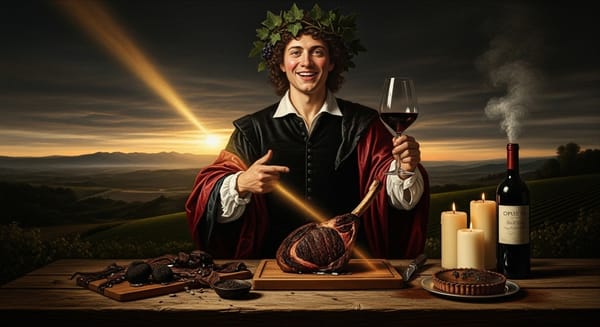2015 Northern Rhône: A Granite Drumbeat That Echoes into the Future
Northern Rhône 2015 Syrah: A monumental benchmark vintage. Its powerful structure, deep color, and granite-forged tension promise decades of aging potential, ranking it alongside the legendary 1961 and 1990. Learn why 2015 is essential for collectors.

The Year's Arc: Sun, Stone, and the Mistral's Hand
The Northern Rhône 2015 vintage began in ease, a healthy spring giving way to a warm, sun-rich summer. August brought the kind of sustained, radiant heat that worries a grower's soul, yet the vines—well-hydrated from a generous winter—met the challenge with resilience. The grapes ripened slowly and evenly, forming small, intensely concentrated berries with thick, vividly colored skins. Critical to the story was the Mistral wind, which swept down the valley, coupled with cool nights. This powerful diurnal swing acted as nature's counterweight, preserving the wines' vital acidity and delicate perfume against the sun's insistent warmth. Harvest was largely clean and unhurried, spanning from early September into October for the higher-altitude plots. The growers’ challenge was a balancing act: capturing the ripeness and density of the sun-drenched fruit without letting the resulting wines feel heavy or hot, demanding precision in the cellar to shape power without austerity.
The Longevity Question: A Tension Forged in Granite
Is 2015 Northern Rhône worth aging? Absolutely. This vintage is already being placed among the modern benchmarks of the valley, sitting comfortably with the likes of 1961, 1990, and the recent classic 2010. What sets it apart is the harmonious marriage of generous ripeness with a profound, structural shape. The wines are deeply colored, possess abundant, ripe, yet firm tannin, and retain a remarkable site transparency. The warmth of the season provided the material (like the great 1990), but the cool nights (the crucial diurnal swing) supplied the backbone and the fresh, energetic line (like the precise 2010) that prevents the wines from collapsing under their own weight. This tension, when handled well in the cellar, is the fuel for longevity, giving 2015 the potential to be a near-mythical year that rivals the great 1961. It’s a vintage built for the long haul, ready to unfurl its complex narrative over decades.
Tasting the Narrative: Ink, Iron, and Twilight Whisper
Pouring the 2015 is like watching a soundless gong strike in a darkened room—the color is a deep, near-opaque black-ruby that seems to absorb the light. The aroma initially suggests a deep dive into blackberry, blackcurrant, and dark blue fruit, immediately contrasted by savory notes of olive tapenade, cured smoked meat, and a finely milled dusting of graphite and violet. It’s an intellectual perfume, not a simple fruit bomb. On the palate, the entry is often deceptively cool, a river breeze passing over dark stones, before the full weight of the vintage asserts itself. The texture builds to a firm, yet finely granular tannin—like iron filings wrapped in velvet—that carries a mineral tail suggesting wet earth and crushed rock. The wine’s structural line is its signature; it’s a lighthouse beam through basalt smoke, guiding the palate with focus and energy. You can almost feel the presence of the vine; Syrah straightens its shoulders, then whispers pepper and violet under its breath, confirming its noble parentage.
The Valley's Voice: Granite, Schist, and Sun's Direction
In Côte-Rôtie (the "Roasted Slope"), the schist soils of the north imparted their signature heat, yielding rich yet lifted wines where the co-fermented Viognier often provides a necessary floral lift. The tension between the muscular, savory Côte Brune and the more open, fragrant Côte Blonde is beautifully defined in 2015. Growers who embraced judicious whole-cluster (fermenting with the stems) achieved wonderful aromatic complexity. Hermitage lives up to its name, presenting a granite dome of power. The wines here are monumental, almost architectural. Look for the Bessards lieu-dit to deliver iron fist tannin, while Méal contributes plush, sun-gorged fruit, and Greffieux offers aromatic finesse—the trio forming an unbreakable, long-lived core.
Cornas, the south-facing amphitheater of pure granite, gave deeply colored, intense wines dominated by dark fruit, iron, and a profound savory depth. The tannin grain here is notably firm in 2015, demanding patience. Moving south, Saint-Joseph shows its varied arc; the northern, granite-backed crus gave structured, black-fruit driven wines, while the broader southern sections are more immediate. The vintage allowed both to shine, but the granite backbone is key to aging. Crozes-Hermitage, with its wider range of soils, saw its granite parcels soar, providing incredible value in serious, structured Syrah that will outlive many fancier labels. A quick nod to the white Saint-Péray, where the Roussanne and Marsanne shone with the vintage's warmth and acid-preserving nights. The dark horse of 2015 is Saint-Joseph from the high, wind-brushed terraces near Mauves; these wines are often overlooked, delivering Côte-Rôtie energy at a Saint-Joseph price.
Shaping the Energy: Winemaking's Choreography of Time and Wood
The true genius of the Northern Rhône 2015 vintage lies in how it rewarded astute cellar choices. The style spectrum is broad, yet anchored by the vintage’s powerful material. Winemakers made critical decisions on whole-cluster percentage: high percentages (up to $100%) add spice, structural lift, and a peppery core—essential for balancing the ripe fruit. Decisions on extraction were paramount; avoiding aggressive punch-downs or pump-overs in favor of gentle infusion was key to preventing coarse tannins. The goal was to draw out color and flavor without extracting seed and skin bitterness.
Oak format plays a critical role in shaping the final texture. Traditionalists favored large, seasoned foudres or demi-muids (600-liter casks) to allow slow oxygen exchange without imparting excessive vanilla or toast, letting the terroir remain audible. Others used modest percentages of new, smaller barriques to polish the already ripe tannins. ABV tendencies were generally moderate-to-high (ranging from 13% to 14.5%), but the wines feel surprisingly balanced due to the strong acid line. Élèvage length (aging period) was typically 12–24 months, with select prestige cuvées seeing longer aging, allowing the wine’s powerful energy to resolve into quiet complexity, refining the tannin grain without softening the core.
Hands That Shaped the Vintage: Architects of Syrah
The 2015 vintage rewarded growers who understood the power of their fruit and practiced restraint in the winery.
Icons: Jean-Louis Chave's Hermitage is legendary, embodying seamless power and limitless ageability, a study in balance. Auguste Clape produced a Cornas of classic, formidable structure, demanding decades of sleep. Jamet's Côte-Rôtie is a marvel of perfume and finesse, capturing the floral lift above the granite's heat.
Value Plays: Gonon’s Saint-Joseph delivered an energy and concentration far above its station, showcasing the vintage's depth in this appellation. Graillot’s Crozes-Hermitage is a benchmark—complex, earthy, and pure, proving the quality available on the wider plateau. Ferraton’s selection of crus offered classic, well-defined expressions that faithfully channeled the sun and stone.
Wild Cards: Franck Balthazar’s Cornas is rustic, pure, and intensely savory—a throwback style that thrived in the ripe year. Vincent Paris’ Cornas La Geynale is a single-site expression of old-vine intensity and focus. Dard & Ribo in Crozes-Hermitage captured the vintage's joyful side, offering bright, pure fruit balanced by a snappy, peppery structure.
The Unfurling: Windows of Complexity
The 2015 Northern Rhône Syrah wines, with their structured core and ripe tannins, are built for the long evolutionary journey.
Early Charm (Now–2028): Most village-level Crozes-Hermitage and Saint-Joseph. These are currently deep and pleasurable, but benefit from a three-to-four-hour decant to resolve the initial muscularity. Serve cellar-cool, not room-temperature, for aromatic lift
Sweet Spot (2029–2045): Cru Saint-Joseph, good Crozes-Hermitage, Côte-Rôtie (especially those with less new oak), and most second-tier Hermitage/Cornas. This is when the wines begin to shed their primary fruit, introducing complex notes of tobacco, worn leather, and forest floor.
Marathon (2046+): Icon Cornas (Clape, Balthazar), Hermitage from top sites (Chave, Jaboulet La Chapelle), and the most structurally dense Côte-Rôtie. The strong combination of granite backbone and ripe stem inclusion (for those who chose it) has set the stage for a truly remarkable aging arc, creating a profound, tertiary wine for future generations.
Final Reflection
The 2015 Northern Rhône is a magnificent, structured vintage, a Syrah monument sculpted by sun and deep granite. Its power is perfectly balanced by the remarkable tension preserved by the cool nights, ensuring an energetic line against the ripe material. This unique combination guarantees a spectacular, decades-long journey in the cellar for the best examples. Built for the long haul, these wines will age gracefully, evolving into a profound tapestry of tertiary notes.





